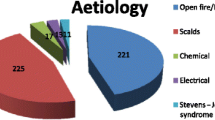Abstract
Background
Burns are the third most common cause of mortality in children and adolescents. Many burns that occur in the first two decades of life are accidental and preventable. The objective of this study was to describe the epidemiology of burn-related injuries in children up to 15 years old in Kosovo.
Methods
This was a retrospective study that included 628 patients with burns, younger than 15 years old who were admitted to the Clinic of Plastic Surgery, University Clinical Center of Kosovo, between 1 January 2006 and 31 December 2015. The patients were categorized into three age groups: 0–3, 4–7, and 8–15 years old. Data on the gender, age, cause, burn size and depth, duration of hospitalization, and treatment were collected and analyzed.
Results
During the study period, in our population, burns in children were predominantly in boys with 374 cases (59.6 %), while 254 patients were girls (40.4 %). Scalding was the most common type of burn with 566 cases or 90.2%.The median TBSA burned was 18.8% with a range of 1–70%. Duration of treatment ranged from 0 to 81 days. The mean hospitalization was 32.2 days.
Conclusions
A high rate of childhood burns in Kosovo requires hospital admissions and prolonged hospital stays. To reduce pediatric burns in Kosovo, a burn-prevention strategy and program should be developed.
Level of Evidence: Level IV, risk / prognostic study



Similar content being viewed by others
References
Rafii MH, Saberi HR, Hossein M, Fakharian E, Mohammadzadeh M (2012) Epidemiology of pediatric burn injuries in Isfahan, Iran. Arch Trauma Res 1(1):27–30
Arslan H, Kul B, Derebasinlioglu H, Cetinkale O (2013) Epidemiology of pediatric burn injuries in Istanbul, Turkey. Ulusal Travma ve Acil Cerrahi Dergisi 19(2):123–126
Balseven-Odabasi A, Tumer AR, Keten A, Yorganci K (2009) Burn injuries among children up to seven years. Turk J Pediatr 51(4):328–335
Fukunishi K, Takahashi H, Kitagishi H, Matsushima T, Kanal T, Ohsawa H et al (2000) Epidemiology of childhood burns in the critical care medical center of Kinki university hospital Osaka, Japan. Burns 26(5):466–469
Duci SB, Arifi HM, Selmani ME, Gashi S (2014) Pediatric burns in university Clinical Center of Kosovo from 2005 to 2010. Burns 14:125–129
Duci SB, Arifi HM, Selmani ME, Mekaj AY, Buja ZA, Hoxha ET, Hamza AR (2014) A retrospective study of 69 patients admitted at the intensive care unit university Clinical Center of Kosovo during the period 2008-2012. Indian J Burns 22:88–92
Arifi HM, Duci SB, Zatriqi VK, Ahmeti HR, Haxhiu II, Mekaj AY, Gashi MM, Buja ZA, Derguti SH (2014) A retrospective study of 572 patients with hand burns treated at the department of plastic surgery Kosovo during the period 2000-2010. Int J Burn Trauma 4(1):7–13
Duci SB, Arifi HM, Ahmeti HR, Selmani ME, Buja ZA, Gashi MM, Zatriqi VK, Mekaj AY (2014) Electrical burn injuries of 246 patients treated at the university Clinical Center of Kosovo during the period 2005-2010. Eur J Trauma Emerg Surg 03:79–86
Tarim A, Nursal TZ, Yildirim S, Noyan T, Moray G, Haberal M (2005) Epidemiology of pediatric burn injuries in southern Turkey. J Burn Rehabil 26(4):327–330
Serour F, Gorenstein A, Boaz M (2008) Characteristics of thermal burns in children admitted to an Israeli pediatric surgical ward. Isr Med Assoc J 10(4):282–286
Kai-Yang L, Zhao-Fan X, Luo-Man Z, Yi-Tao J, Tao T, Wei W et al (2008) Epidemiology of pediatrics burns requiring hospitalization in China: a literature review of retrospective studies. Pediatrics 122(1):132–142
Peden M et al (2008) World report on child injury prevention. World Health Organization, Geneva
National SAFE KIDS Campaign. Burn injury fact sheet 2004, (http://www.preventinjury.org/PDFs/BURN_INJURY.pdf, accessed 1 December 2010).
Papp A, Rytkönen T, Koljonen V, Vuola J (2008) Paediatric ICU burns in Finland 1994-2004. Burns 34:339–344
Dekker R, Dokter J, Oen IMMH. Where do the patients of 0–4 years in the burn centre Rotterdam come from? Consumer and Safety Report, The Netherlands, 2005.
Lin TM, Wang KH, Lai CS, Lin SD (2005) Epidemiology of pediatric burn in southern Taiwan. Burns 31(2):182–187
Duci SB, Arifi HM, Ahmeti HR, Zatriqi VK, Buja ZA, Hoxha ET, Mekaj AY (2015) Outcomes of older adults with burn injury: university Clinical Center of Kosovo. World J Plast Surg 4(2):153–158
Macarthur C (2003) Evaluation of safe kids week 2001: prevention of scald and burn injuries in young children. Injury Prevention 9:112–116
Erdmann TC, Feldman KW, Rivara FP, Heimbach DM, Wall HA (1991) Tap water burn prevention: the effect of legislation. Pediatrics 88:572–577
Ytterstad B, Sogaard A (1995) The Harstad injury prevention study: prevention of burns in small children by a community-based intervention. Burns 21:259–266
Waller AE, Clarke JA, Langley JD (1993) An evaluation of a programme to reduce home hot tap water temperature. Aust J Public Health 17:116–123
Han RK, Ungar WJ, Macarthur C (2007) Cost-effectiveness analysis of a proposed public health legislative/educational strategy to reduce tap water scald injuries in children. Injury Prevention 13:248–253
Acknowledgments
We thank the archive and all the staff of the Clinic of Plastic Surgery for their technical support.
Author information
Authors and Affiliations
Corresponding author
Ethics declarations
Conflict of interest
Hysni M. Arifi, Shkelzen B. Duci, Zejn A. Buja, Violeta K. Zatriqi, Havushe I. Ramadani, Ngadhnjim H. Arifi, and Hasan R. Ahmeti declare that they have no conflict of interest.
Patient consent
For this type of study informed consent is not required.
Ethical approval
For this type of retrospective study formal consent is not required.
Funding
None.
Rights and permissions
About this article
Cite this article
Arifi, H.M., Duci, S.B., Buja, Z.A. et al. Epidemiology of pediatric burn injuries in Kosovo. Eur J Plast Surg 40, 123–126 (2017). https://doi.org/10.1007/s00238-016-1251-1
Received:
Accepted:
Published:
Issue Date:
DOI: https://doi.org/10.1007/s00238-016-1251-1




